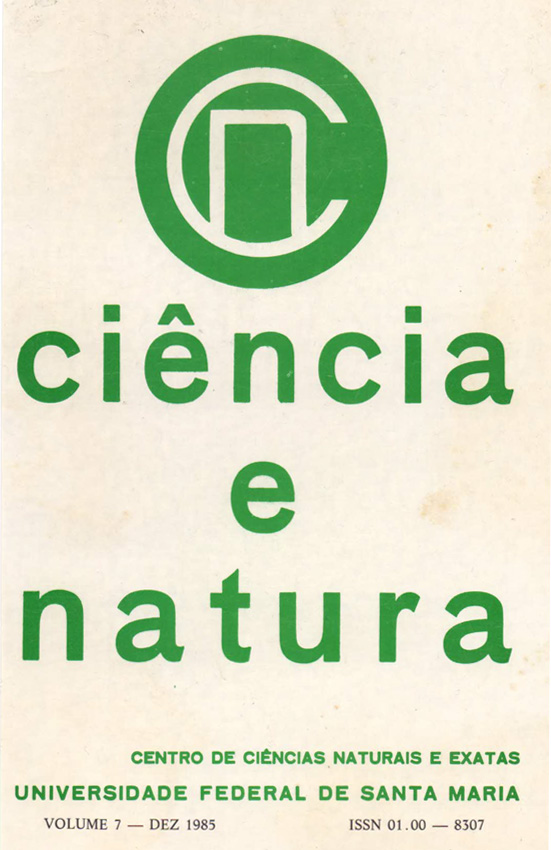Native caesalpinioideae and Mimosoideae species of RS, Brazil, with foraging valve – A Review
DOI:
https://doi.org/10.5902/2179460X25420Abstract
This work aimed at gathering information about native Caesalpinioideae and Mimosoideae species with foraging value. Nirle species were classified as, Caesalpinia epunctata (Vog.) Benth., Cassia patellaria DC., Cassia pilifera Vogh., Cassis repens Vog., Cassis rotundifolia Pers., Desmanthus depressus Humb. & Bonpl. ex Willd.,Mimosa dutrae Malme., Mimosa flagellaris Benth., Prosopis Algarobila Griseb. Except C. rotundifolia, herbaceous, and P. algarobilla, weady, the other species are perennials altough C. patellaria may behave as annual in some cases. According to the data obtained, the species present summer growth and are generally found in dry fields. Regarding the potential forage value; Caesalpinia epunctata, Cassia repens, Desmanthus depressus and Mimosa flagellaris are considered as regular forages while Cassia pilifera and Cassia patellaria are poor forages. Cassia rotundifolia presents a soft forage well accepted by catlle in several regions of the country but not in the South where even cultivation trials failed. Prosopis algarobilla, altough restricted to a small area of the State, seems to be a species with good potential as a forage.
Downloads
References
ALCÂNTARA, P.B., BUFARAH, G. 1979. Plantas Forrageiras: gramíneas e leguminosas. São Paulo, Nobel. 150 p.
ARAÚJO, A.A. de. 1942. Forrageiras para o sul do Brasil. Porto Alegre, Secretaria de Estado dos Negócios da Agricultura, Indústria e Comercio. 258 p.
BARRETO, I.L. & KAPPEL, A. 1969. Principais espécies de gramíneas e leguminosas das pastagens naturais do Rio Grande do Sul. In: CONGRESSO NACIONAL DE BOTANICA, 159, Porto Alegre, 1969. Anais, Porto Alegre, Globo. p. 281.
BENTHAM, G. 1881. Leguminosae. I, II. In: MARTIUS, C.F.P. Flora brasiliensis. Monachii, R. Oldenburg.
BURKART, A. 1939. Descripción de Mimozyganthus, nuevo genero de leguminosa y sinopsis preliminar de los generos argentinos de Mimosoideae. Darwiniana, B. Aires, 3(3):445-469.
___________. 1940. Materiales para una monografia del genero Prosopis (leg.). Darwiniana, B. Aires, 4(1):57-128.
___________. 1952. Las leguminosas argentinas silvestris y cultivadas. 2 ed. B. Aires, Acme. 569 p.
___________. 1979. Leguminosas: mimosoideas. Flora Ilustrada Catarinense, Itajai, LEGU. 304 p.
CABRERA. A. 1953. Manual de la flora de los alredores de Buenos Aires. B. Aires. Acme. 589 p.
___________. 1965. Flora de la província de Buenos Aires. B. Aires, INTA. pt. 3, 671 p.
LEONARDIS. R.F.S. 1975. Livro del arbol: essencias florestales indigenas de la Argentina de aplicación industrial. B. Aires, Celulosa argentina. s.p.
MANGANARO. A. 1919. Leguminosas bonaerenses. Anales de la Soc.Cient. Arg., B. Aires. 87:77-264.
NATIONAL ACADEMY OF SCIENCES. 1979. Tropical legumes: resources for the future. Washington. National Academy of Sciences. 331 p.
PARODI, L.P. 1959. Enciclopédia argentina de agricultura y jardineria. B. Aires, Acme. 931 p.
PIMENTEL GOMES, R. 1975. Forragens fartas na seca. São Paulo, Nobel. 233 p.
RAMBO, B. Leguminosae riograndenses. 1966. Pesquisas, São Leopoldo (23).
ROCHA, G.L. da. 1971. Introdução e seleção de leguminosas forrageiras tropicais. In: SEMINÁRIO SOBRE METODOLOGIA E PLANEJAMENTO DE PESQUISA COM LEGUMINOSAS TROPICAIS, Rio de Janeiro, 1971. Anais, Rio de Janeiro, J. Döbereiner, P.A. da Eira, A.A. Franco e A. B. Campelo. p. 19-70.
ROCHA, G.L. da; LEITÃO FILHO, H. de F.; ANDRADE, J.B.; SHEPHERD, E. J. SEMIR, J.; GOUVÊA, L.S.K.; GIBBS, P.E.; TAMASHIRO, J.; MONTEIRO, R.; ALCÂNTARA, P.B.; BUFARAH, G.; OLIVEIRA, P.R.P. de.; ALCÂTARA, V.B.G.; ALMEIDA, J.E. de.; SALGADO, P.R.; PULZ, F.S.;SIGRST, J.M.M.; FONSECA, T.C.; PAULINO, V.T. 1979. Coleta, identificação e distribuição de leguminosas forrageiras tropicais brasileiras - Brasil Central - Fase 1. B. Ind , Anim., Nova Odessa, 36(2):255-324.
Downloads
Published
How to Cite
Issue
Section
License
To access the DECLARATION AND TRANSFER OF COPYRIGHT AUTHOR’S DECLARATION AND COPYRIGHT LICENSE click here.
Ethical Guidelines for Journal Publication
The Ciência e Natura journal is committed to ensuring ethics in publication and quality of articles.
Conformance to standards of ethical behavior is therefore expected of all parties involved: Authors, Editors, Reviewers, and the Publisher.
In particular,
Authors: Authors should present an objective discussion of the significance of research work as well as sufficient detail and references to permit others to replicate the experiments. Fraudulent or knowingly inaccurate statements constitute unethical behavior and are unacceptable. Review Articles should also be objective, comprehensive, and accurate accounts of the state of the art. The Authors should ensure that their work is entirely original works, and if the work and/or words of others have been used, this has been appropriately acknowledged. Plagiarism in all its forms constitutes unethical publishing behavior and is unacceptable. Submitting the same manuscript to more than one journal concurrently constitutes unethical publishing behavior and is unacceptable. Authors should not submit articles describing essentially the same research to more than one journal. The corresponding Author should ensure that there is a full consensus of all Co-authors in approving the final version of the paper and its submission for publication.
Editors: Editors should evaluate manuscripts exclusively on the basis of their academic merit. An Editor must not use unpublished information in the editor's own research without the express written consent of the Author. Editors should take reasonable responsive measures when ethical complaints have been presented concerning a submitted manuscript or published paper.
Reviewers: Any manuscripts received for review must be treated as confidential documents. Privileged information or ideas obtained through peer review must be kept confidential and not used for personal advantage. Reviewers should be conducted objectively, and observations should be formulated clearly with supporting arguments, so that Authors can use them for improving the paper. Any selected Reviewer who feels unqualified to review the research reported in a manuscript or knows that its prompt review will be impossible should notify the Editor and excuse himself from the review process. Reviewers should not consider manuscripts in which they have conflicts of interest resulting from competitive, collaborative, or other relationships or connections with any of the authors, companies, or institutions connected to the papers.






